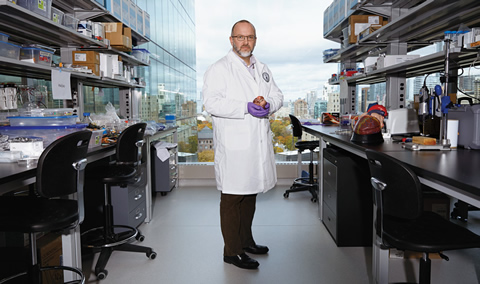
At his lab at the Ted Rogers Centre for Heart Research, U of T scientist Craig Simmons works on growing replacement tissue for the pulmonary heart valve. Photo by Caroline Ryan.
January 23, 2017 – Research by MIE professor Craig Simmons at the Ted Rogers Centre for Heart Research, supported by a visionary gift from the Rogers family, could one day eliminate the need for infants with heart defects to have more than one surgery.
Craig Simmons recalls having given a presentation not long ago about promising new heart research in children, when a mother came up to him crying. Her tears reflected the stress of being the parent of a child born with a congenital heart defect as well as gratitude that researchers like him were working on better solutions. “That really touched me,” says Simmons, who is scientific director of the translational biology and engineering program at the Ted Rogers Centre for Heart Research. It also motivated him as he continues his work on creating “living tissue” heart valves to replace defective ones in infants.
The Ted Rogers Centre – created through an unprecedented $130-million donation from the Rogers family – brings together more than 30 experts from Sick Kids, University Health Network and the University of Toronto to address heart failure across the lifespan. “We know Ted would have been proud of this bold initiative that will improve heart health for all,” says Loretta Rogers, wife of the late Ted Rogers.
We tend to think of heart disease as a problem in older adults, but children can have heart disease too. One in 100 babies in Canada is born with a congenital heart defect. In a healthy heart, the four valves open and close with every heartbeat, allowing blood to flow only one way. But a malfunctioning valve may leak, preventing a baby from getting enough oxygen-rich blood. This increases the risk for the child of infection, fatigue, fainting, delayed development, heart failure and sudden cardiac death.
The current treatment involves an initial surgery to repair or replace the defective valve in a tiny infant. Further complex operations are often required as the child outgrows the synthetic patch or valve, which are made of fabric, metals or plastics. But Simmons hopes “living tissue” heart valves that grow with the child will eliminate the need for those subsequent surgeries. “The kids would still need that single operation,” Simmons says, “but then they’d never need another.” Nor would they require maintenance medication such as blood thinners or anti-rejection drugs, as the new valve would be made from the baby’s own cells.
Simmons heads a research team focusing on growing replacement tissue for the pulmonary heart valve. The team harvests stem cells from a baby’s umbilical cord – typically discarded after birth – and attaches them to a polyurethane scaffold. Through chemical and mechanical stimulation – sort of like forcing the cells to do bodybuilding – the growing tissue becomes stronger and stiffer. Once implanted, the scaffolding would harmlessly biodegrade. Buoyed by early lab results, the team is now optimizing the processes for future animal testing.
“I’ve met people who as children had congenital heart problems – this past summer, one of them was a student who worked in my lab – and I’ve seen what an emotional burden this can be on children and families,” says Simmons. The costs to the health-care system are also significant.
